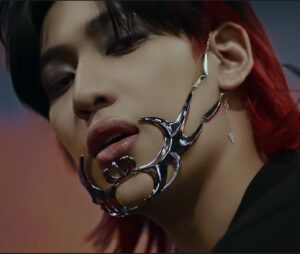On the surface, BamBam’s latest title track “Last Parade,” whose MV opens with an extreme close up of his reddened eyes, could not differ more from his previous solo work, whether his bright debut “Ribbon” or the moody “Who Are You?” Similarly, the song’s heavy hip hop beats mark a departure from the synthwave “Sour and Sweet” or vibey “Slow Mo”.
A thematic throughline in his title tracks, however, seems to be a focus on identity. “Ribbon” plays with the similarity to the word “reborn”, while “Sour and Sweet” asserts, “Every single person has a B-side.” As its title suggests, people are multifaceted, both sour and sweet. “Last Parade” continues BamBam’s fascination with different selves through its visually stunning MV. Referencing famous paintings and pop culture, “Last Parade” depicts BamBam in an internal struggle with various personas.
The video is divided into 3 chapters, each with distinct aesthetic influences. The director is Digipedi’s Seong Wonmo, whose previous work (namely Ateez’s “Guerrilla” and ARTMS’ “Birth”) incorporates literary or film references into dark or dystopian imagery. Chapter 1 adopts a similar approach, drawing upon the fantastical depictions of hell in Hieronymus Bosch’s The Garden of Earthly Delights. BamBam appears as a horseman in Hell, riding in a boat in a blood red river. As with Bosch’s work, every frame of the MV is a grotesque yet gorgeous painting. The scenes are rich with retro-futuristic details (UFOs, robot with an antennaed TV set for a head) and steampunk styling for the supporting players’ headwear.
In Chapter 1, BamBam also adopts a second persona as a leader of a totalitarian regime. This earthly setting has parallels to a hellscape, such as its red and black color palette of BamBam’s military uniform. The grey concrete buildings bear the same black flags that BamBam’s horseman carries, suggesting a connection between the two characters.
The MV is segmented intuitively, with a different character taking focus for each element of the song. Following the rap verse from the horseman, the despotic leader sings: “Everything I do in my way, feel like I’m a lion.” BamBam plays a third character in the underworld who sings the pre-chorus. Due to the strong storytelling and editing choices, the song’s musical changes might surprise, but they do not feel jarring. Specifically, when the beat drops to a mostly instrumental chorus, the image also cuts from a close-up of BamBam to a panoramic view of the underworld, with all of BamBam’s personas in the frame. The combined music and image is shocking but also caps the chapter up until that point.
Perhaps the most satisfying sonic shift occurs in the post-chorus, where the beats accelerate into a club dance break. In some of the only choreography sequences in the MV, BamBam and his dancers waack, which projects confidence and self-empowerment. The slightly muffled background vocals mutter, “Black and red,” symbolizing passion and power, but also danger. BamBam’s sharp, expressive waacking evokes all these qualities.
With the second verse, the narrative shifts to Chapter 2, where BamBam portrays a motorcycle-riding revolutionary leader. Surrounded by masked figures in draped clothing atop scaffolding, Chapter 2’s scenes resemble Mad Max. The color palette, dominated by red, black, and grey in the first verse, shifts to white and orange (largely from the costuming and the smoke in the background of the dance segments). The camera movements also become more dynamic, with seemingly hand-held cameras bouncing as though also dancing. As a result, the second waacking sequence feels like an anarchic rave.
Chapter 3 arrives with the bridge. With a layered chorus of “ohs” and background chanting of “last parade, last parade,” the bridge has an anthemic feel. Fittingly, the MV depicts an epic battle between the Chapter 1 and Chapter 2 BamBams in the sky. Returning to the feel of Bosch or Renaissance paintings, the MV portrays a monumental conflict between BamBam’s different selves.
As the camera tilts down, more of the hellish skeleton figures are revealed, having taken over the earth and infiltrating the heavens. It appears that BamBam’s rebel leader is taking his last stand against the dark powerful forces from within that threaten to overtake everything.
The album title Bamesis (which also appears in the lyrics of the pre-chorus) derives from BamBam’s name and another word — perhaps nemesis, but more likely genesis. “Last Parade” thus dramatizes that internal battles can lead to new beginnings. Viewers do not see the outcome of the war in Chapter 3, but they can perceive the “genesis” of a distinct artistic identity for BamBam. “Last Parade” serves as both the culmination of BamBam’s exploration of identity and the assertion of a bold new direction.
(YouTube. Lyrics via YouTube. Images via The Abyss Company).



